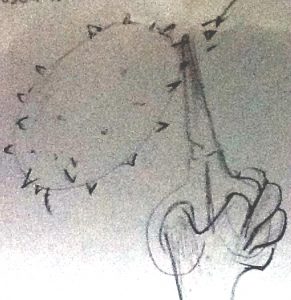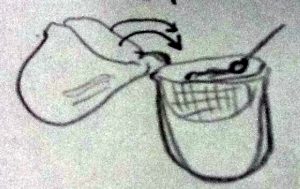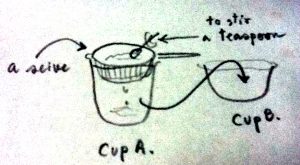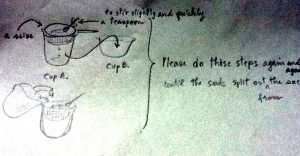While preparing to write the original Horned Melon/Cucumis metuliferus article, I ate the green “jelly” part of the fruit and spat out the seeds. One Horned Melon gave me a single serving of fruit and some seeds. That’s all. No more. Unless you count what I tossed into the compost bin. There was so much wasted that I simply did not “see” as food.
My friend Plant Sister, who lives in southeast Asia, thought my article could have been more complete. She shared with me what she had learned from her mother. Plant Sister wrote the instructions for this article and provided photos and original drawings; I did the editing, adding three photos and a few comments, and I learned a lot in the process!
From a single Horned Melon fruit, Plant Sister can get:
One small bottle of the green Horned Melon juice (approximately 30% juice/70%water),
One small cup of green Horned Melon “jelly,”
One tablespoon of orange Horned Melon “meat,”
Plus all the seeds… “Seed for sharing with people who love to grow their own food,”
Horned Melon Peel, to be dried and later used to make a tea.
Plant Sister thought it would be good to explain how to utilize the many parts of the Horned Melon so that more people could learn how useful this fruit is. She said, “Thank you for letting me have a chance to tell you about my experience with the method. I took the fruit in my hand and …did it step by step…learning by doing.”
The steps:
—Use scissors to cut each tip of the sharp horn of the Horned Melon as my drawing shows.
Please cut only the hard horn at the tip of each horn to avoid getting jabbed with the sharp points.


—Wash the Horned Melon in a salt solution (about 1/2 teaspoon salt dissolved in 3 cups of water). —–Do not rinse. Let air dry.
—Cut the fruit, scoop out the green jelly and seeds; each seed is inside a sac.


Now we will make the juice/water mixture and retain the green pulp:
—Place a colander into a bowl. Put the green seed sacs into the colander.
—Prepare 60 ml. water. Please use water that has been boiled and allowed to cool to room temperature.
—Pour the water onto the seed sacs. Using a teaspoon, “stir lightly but quickly to separate the seeds from the sacs.”Put the green seed sacs into the colander.



—Reserve the water and use this water to repeat the sieving process again and again until all the seeds have separated from the sacs.
—After the last sieving, save the water, which will be approximately a 30%/70% Horned Melon juice/water mixture. Remove everything from the colander.
Once the seeds and the green sacs/solids/jelly are separated, place each part in a cup: seeds in one cup, solids in another cup.
“In addition to the juice/water mixture we now we have one amount of the seeds and one amount of green sacs/solids/jelly each in a small cup.”
 Here is a bowl of the green “jelly” after the seeds have been removed.
Here is a bowl of the green “jelly” after the seeds have been removed.
When I was preparing my Horned Melon, that was my stopping point. Plant Sister takes this a bit further, obtaining more food from the single fruit. She has kindly included her own drawings to show the process.
—Use a tablespoon to scrape the orange-colored “meat” from inside the peel/rind as the photo shows.

The Horned Melon meat is mixed with the water and some coconut sugar and a bit of salt are added.

Plant Sister says: “It had a sweet smell of the coconut sugar.”
—Using scissors, cut the outer peel of the Horned Melon fruit into julienne strips. Allow the peel to dry.
Note: if you live in a damp climate you may want to use a dehydrator for this process. “This is the photo of the dried peel, which we can use for tea”.

“I am very happy I can teach the method to other people. This method will be useful to them, and the original article about the Horned Melon will be more complete. Thank you for letting me have a chance to tell everyone about my experience with the method. Please have a good day today. I hope you like ‘all’ the Horned Melon today!”
Plant Sister
Plant Sister’s mother, who is over 94 years of age, will be smiling today, knowing that more people have learned not to let food go to waste. Using Plant Sister’s method you can now use everything but the horns.
Photos, instructions and original drawings by Plant Sister.
Photos by therealmgreene: Horns, Pulp with seeds, Seed in Sac.
Edited by therealmgreene.
Originally published February 2015